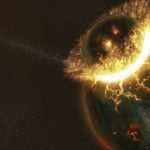Key Takeaways:
- Black holes may not be true “holes” but rather dark stars with incredibly dense cores, challenging established notions.
- These hypothetical dark stars could hold the key to understanding the elusive nature of dark matter, a dominant force in the cosmos.
- By sidestepping the singularity problem, dark stars offer a unique perspective to bridge quantum mechanics and general relativity.
- If real, dark stars might emit particles akin to dark matter, potentially explaining the rapid rotations of stars around galaxies.
- This innovative theory also proposes a link between dark stars and the enigmatic phenomenon of fast radio bursts (FRBs).
In a radical departure from established cosmological theory, scientists are postulating that black holes, those cosmic devourers of light, may not be the dark chasms we imagine.
Instead, a provocative new hypothesis suggests they could be “dark stars” harboring cores of exotic and astoundingly dense matter. This notion not only challenges our conventional understanding of black holes but could hold the key to unlocking the mysteries surrounding dark matter, one of the universe’s most elusive constituents.
Black holes, monumental manifestations of Einstein’s theory of relativity, are locales in the cosmos where staggering concentrations of matter stretch the very fabric of space-time to its limits, engendering an infinitely deep gravitational well from which not even light can escape, thus earning them their moniker.
At the heart of each black hole, it is theorized, resides a singularity—a point infinitesimally small and dense. Gravity here is so overpowering that it begets an event horizon, a boundary within which even the speed of light is surpassed.
Yet, this singularity poses a conundrum, defying the known laws of physics. Matter cannot plausibly collapse into an infinitely minuscule point. Physicists have ingeniously evaded this issue by envisioning their own singularity-free versions of black holes, termed “dark stars.” These imaginative constructs mimic black holes externally but house an extraordinarily dense core compressed to the smallest conceivable scale, or a “Planck core,” named after the minuscule Planck length.
Devoid of a singularity, a dark star theoretically permits light to escape its potent gravitational clutches. Any light that manages this feat is stretched akin to a slinky, a phenomenon scientists dub “redshift.” This property, posited by physicist Igor Nikitin, could reshape our understanding of dark matter.
Nikitin contends that if black holes contained Planck cores, they might serve as a wellspring for dark matter. His study suggests that dark stars could continually emit particles in the form of dark matter, enough to elucidate the rapid rotations of stars around galaxies.
Nikitin postulates that the dark matter might consist of familiar particles, albeit in an extraordinary state. These particles could be as elementary as photons, the constituents of light, but redshifted to wavelengths so vast they are virtually imperceptible to contemporary radio telescopes.
He remarks, “It is an extremely large wavelength, about 4 light days, 16 times the Sun-Pluto distance.” While the energy of these photons would be exceedingly minute, their sheer abundance could elucidate the peculiar motion of stars around galaxies.
Furthermore, Nikitin’s theory ventures into the enigma of fast radio bursts (FRBs), intense, transient emissions of radio waves discovered in 2007. Their origin remains elusive, but Nikitin speculates that if an object were to plunge into a Planck core, it could unleash a burst of high-energy light waves. The formidable gravity of the dark star would redshift the light, fabricating an apparent FRB detectable on Earth.
While dark stars have yet to replace the entrenched theory of black holes, Nikitin’s proposal is a testament to the power of unconventional thinking in tackling ostensibly insurmountable problems. It opens the door to a realm of possibilities, potentially illuminating two of the universe’s most profound enigmas.


